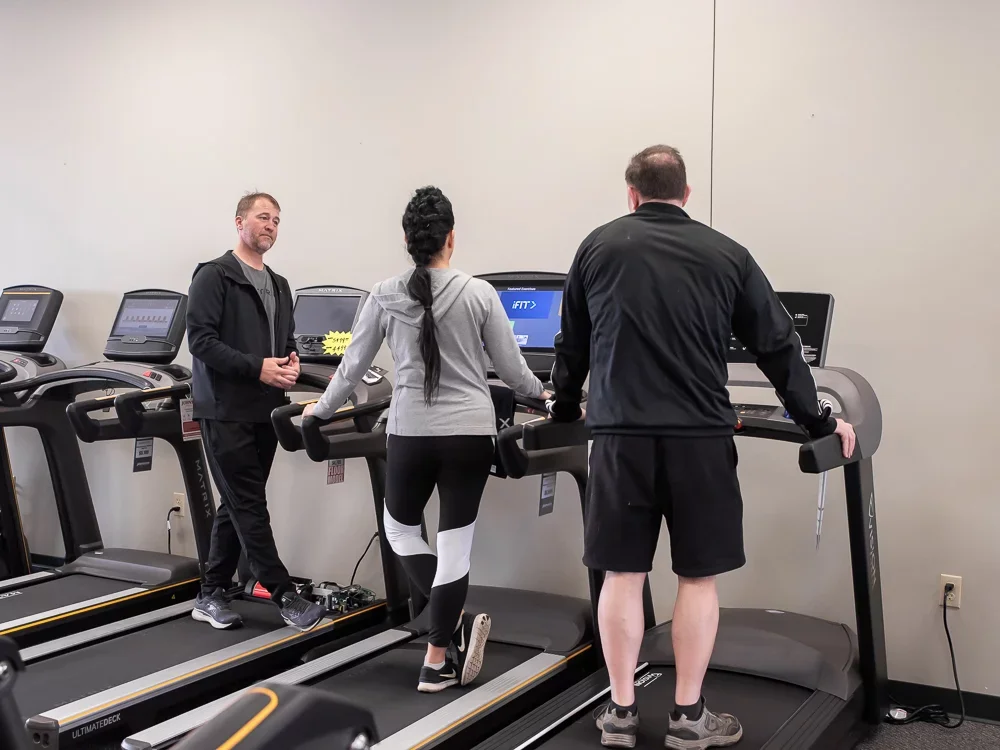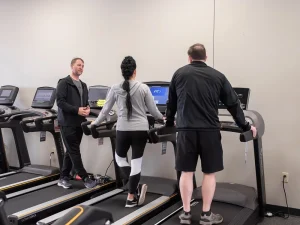How to Create Effective Treadmill Intervals
There are now Treadmill Group Classes all over the United States. Boutique studios like The Mile High Run Club in New York and Barry’s Bootcamp(BBC) of San Diego, Calif. have included coached treadmill intervals workouts into their programming. Equinox and LifeTime Fitness, two high-end gyms that cater to the elite market, offer similar formats. Some formats are based solely on running while others include strength training in this high-intensity, interval training (HIIT), format.
It’s not a secret that HIIT works. Research suggests that runners who incorporate high-intensity training can achieve significant results. Gunnarsson and Bangsho found that runners who used the 30-20-10 method showed dramatic improvements in performance. The participants ran 30 seconds low intensity, followed by 20 seconds medium intensity, and then 10 seconds high intensity over three or four blocks of five minutes. Each block was then followed by a 2-minute rest. In only seven weeks, the 1500-meter runners’ average time improved by 23 seconds, and the 5k runner’s showed an improvement of one minute, while their total training time was cut in half.
What does this mean for our members and clients? BBC San Diego members shared their experiences on how high-intensity runs have improved their running. Most members attend class twice to three times per week when “in training”. When “in training”, members usually attend three to four classes a week.
Natalie F. is a Boston Marathon finisher who was able cut 6 minutes from her half-marathon time and 12 minutes from her full marathon. Ronnie G. is an active military member who was able reduce his half-marathon from 2:06 down to 1:31, and his full-marathon from 4:34 down to 3:26.
Not everyone who attends these classes is a competitive racer. These classes may be the only thing they do during the week. They can also be used to lose weight or maintain fitness. When Kerri R. first started at BBC, she ran at a steady pace of 6.0 mph while sprinting at an 8.0 mph. After regular treadmill intervals she has improved her pace to 9.1 to 9.5mph for her steady run and 12.1 mph for her sprint. These intervals are credited with her increased speed and ability to return to her “pre-pregnancy weight” quickly.
Use these guidelines to unleash your creativity if you want to coach treadmill classes or incorporate treadmill intervals in your clients’ workouts:
- Consider the goal for the interval. For example, maintaining speed and changing incline. There are many options. You can choose between endurance sets of eight to ten minutes, mid-length set between four and six minute and short sets from 30 seconds to three minutes.
- How long is the interval between the two?
- Calculate the work/rest balance. You can use your heart rate and the ratings of perceived effort (RPE) as a guide to determine whether you need more or less sleep.
- Decide if you can repeat an interval slightly differently after writing it. This will allow the client to see the progress made and be encouraged to push harder in the second round.
There are two intervals in each set: endurance, mid length and short.
Note: “+1” indicates an increase in speed of 1 mph. “+2”, a 2 mph increase. If “+1” was indicated, for example, if you jogged the first minute at 5.0 mph then the second minute should be run at 6 mph.
Endurance (8-10 Minutes)
Interval 1 (9 minutes)
Coaches’ cues: Break the drill into three-minute segments. You’ll go through three speeds for one minute, then cycle through these intervals twice more to complete the nine-minute set.
- Jog for 1 minute at 2% (5 mph).
- 1 minute jog + 1% (6.0 mph).
- 1-minute run flat (7.0 mph)
- Jog for 1 minute 4%
- 1 minute jog + 3%
- 1-minute run 2%
- 1 minute jog 6%
- 1 minute jog + 4%
- 1-minute run 2%
- Rest for two minutes.
You can repeat the drill. Once you are warmed up you can remove the jog, start at a jog +1, then move to a running pace and finish with a run +1 (8.0 mph).
Interval # 2 (9 minutes )
Coaches’ cues: For the first three minutes, the drill is done at a 1% incline. The second three minutes are performed at 3% and the last three minutes at 1%. As you adjust the incline, you’ll need to increase your speed by one mile per hour and then pull it back.
- Jog for 1 minute at 1%
- 1 minute jog + 1%
- 1-minute run 1%
- 1 minute jog + 3%
- 1 minute run at 3%
- 1-minute run +1 3%
- 1-minute run 1%
- 1-minute run +1 1%
- 1-minute run +2 1%
- Rest for two minutes.
You can repeat the drill with different inclines.
Mid-length (4-6 minutes)
Interval 1: 6 minutes
Coaching cues: Break this six-minute period into three segments of two minutes each. You will jog two minutes, then jog +2 for another two and finish with a two-minute run. The first minute is always at zero incline. But the second minute, you will add some incline.
- Jog for 1 minute on flat
- Jog for 1 minute 5%
- 1 minute jog + flat
- 1 minute jog + 4%
- 1-minute run flat
- 1-minute run 3%
- Rest for 1-2 Minutes.
You can repeat this set with a faster pace at the start (jog +1) or an increase in the incline.
Interval 2 (4 minutes)
Coaching cues: It’s a four minute hill run. You must maintain your running speed for the duration: one minute at each of 2%, 4.4%, 6.8% and 8.0%. You can stop if you have to, but first, jump off the treadmill. Then, jump back on, continuing at your pace.
In this case, you would modify the speeds as needed to last the full four minutes (instead of taking a break). You would then modify your speed to ensure that you can last for the entire four minutes.
- 1-minute run 2%
- 1-minute run 4%
- 1-minute run 6%
- 1-minute run 8%
- Rest for two minutes.
You can repeat this drill as a hill descent, increasing the speed as you descend the hill.
Short (30 Seconds-3 Minutes)
Interval 1: (3 minutes)
Coaching cues: The drill should last three minutes, and be repeated three times. The first minute begins on a slope, then drops down to the flat ground before returning back up to the hill. Each set is progressively faster and lower in incline.
- 1 minute jog 8%
- 1-minute run flat
- 1 minute jog 8%
- Rest for one minute.
- 1 minute jog + 6%
- 1-minute run +1 flat
- 1 minute jog + 6%
- Rest 90 seconds.
- 1-minute run 4%
- 1-minute run +2 flat
- 1-minute run 4%
- Rest for two minutes.
You can also reverse the order of this drill.
Interval 2 (duration can vary from 3 minutes up to 90 seconds).
Coaching cues: In these three sets, you’ll be hitting three different speeds: jog and run. The first set is three minutes long, the second two minutes 15 seconds and the third 90 seconds.
- 1 minute jog 6%
- 1-minute run 4%
- 1-minute sprint 2%
- Rest for one minute.
- 45-second jog at 8%
- 45-second run: 6%
- 45-second sprint 4%
- Rest 90 seconds.
- 30 second jog 10%
- 30 second run 8%
- 30 second sprint 6%
- Rest for two minutes.
Repeat this drill by adding 0.1 to 0.5 mph for each segment.
When you start creating intervals, be sure to test them first. If you are teaching in a one-on-one or group setting, ensure that participants feel successful and challenged. You may be pushing your students too hard if you expect them to run up a hill when the majority are walking. The speed goals may have been too high, the set too long or the students were not recovered enough to start the next set. The key to success is to observe and modify the drills according.














Post Comment